Marketing Plan and Interrelationships: KFC UK Report
VerifiedAdded on 2022/12/27
|22
|6903
|1
Report
AI Summary
This report provides a comprehensive analysis of KFC's marketing strategies, focusing on the role of marketing within a hospitality organization. It explores the key roles and responsibilities of the marketing function, including market research, branding, and marketing planning. The report examines KFC's internal and external marketing environment using SWOT and PESTEL analyses, highlighting strengths, weaknesses, opportunities, and threats. It further delves into how marketing interrelates with other functional units, such as operations and finance, and discusses the application of the marketing mix (7Ps) to achieve business objectives. The report also develops a basic marketing plan for KFC UK, outlining its mission, goals, and strategic objectives, including e-commerce, digital marketing, personalization, and ethical considerations. Finally, the report emphasizes the significance of adapting to current and future marketing trends in the fast-food industry to maintain a competitive advantage.
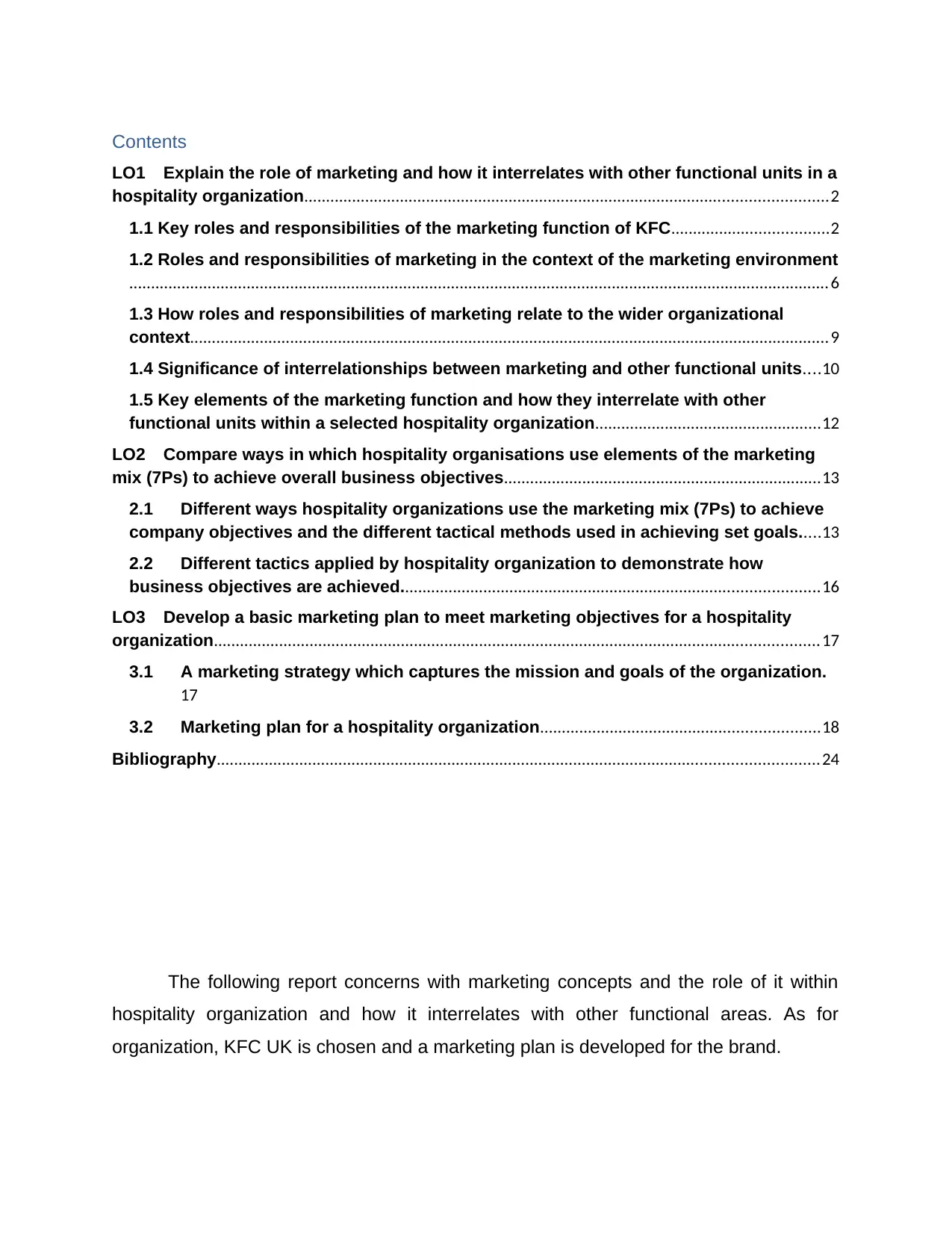
Contents
LO1 Explain the role of marketing and how it interrelates with other functional units in a
hospitality organization........................................................................................................................2
1.1 Key roles and responsibilities of the marketing function of KFC....................................2
1.2 Roles and responsibilities of marketing in the context of the marketing environment
.................................................................................................................................................................6
1.3 How roles and responsibilities of marketing relate to the wider organizational
context...................................................................................................................................................9
1.4 Significance of interrelationships between marketing and other functional units....10
1.5 Key elements of the marketing function and how they interrelate with other
functional units within a selected hospitality organization....................................................12
LO2 Compare ways in which hospitality organisations use elements of the marketing
mix (7Ps) to achieve overall business objectives.........................................................................13
2.1 Different ways hospitality organizations use the marketing mix (7Ps) to achieve
company objectives and the different tactical methods used in achieving set goals.....13
2.2 Different tactics applied by hospitality organization to demonstrate how
business objectives are achieved................................................................................................16
LO3 Develop a basic marketing plan to meet marketing objectives for a hospitality
organization...........................................................................................................................................17
3.1 A marketing strategy which captures the mission and goals of the organization.
17
3.2 Marketing plan for a hospitality organization................................................................18
Bibliography..........................................................................................................................................24
The following report concerns with marketing concepts and the role of it within
hospitality organization and how it interrelates with other functional areas. As for
organization, KFC UK is chosen and a marketing plan is developed for the brand.
LO1 Explain the role of marketing and how it interrelates with other functional units in a
hospitality organization........................................................................................................................2
1.1 Key roles and responsibilities of the marketing function of KFC....................................2
1.2 Roles and responsibilities of marketing in the context of the marketing environment
.................................................................................................................................................................6
1.3 How roles and responsibilities of marketing relate to the wider organizational
context...................................................................................................................................................9
1.4 Significance of interrelationships between marketing and other functional units....10
1.5 Key elements of the marketing function and how they interrelate with other
functional units within a selected hospitality organization....................................................12
LO2 Compare ways in which hospitality organisations use elements of the marketing
mix (7Ps) to achieve overall business objectives.........................................................................13
2.1 Different ways hospitality organizations use the marketing mix (7Ps) to achieve
company objectives and the different tactical methods used in achieving set goals.....13
2.2 Different tactics applied by hospitality organization to demonstrate how
business objectives are achieved................................................................................................16
LO3 Develop a basic marketing plan to meet marketing objectives for a hospitality
organization...........................................................................................................................................17
3.1 A marketing strategy which captures the mission and goals of the organization.
17
3.2 Marketing plan for a hospitality organization................................................................18
Bibliography..........................................................................................................................................24
The following report concerns with marketing concepts and the role of it within
hospitality organization and how it interrelates with other functional areas. As for
organization, KFC UK is chosen and a marketing plan is developed for the brand.
Paraphrase This Document
Need a fresh take? Get an instant paraphrase of this document with our AI Paraphraser
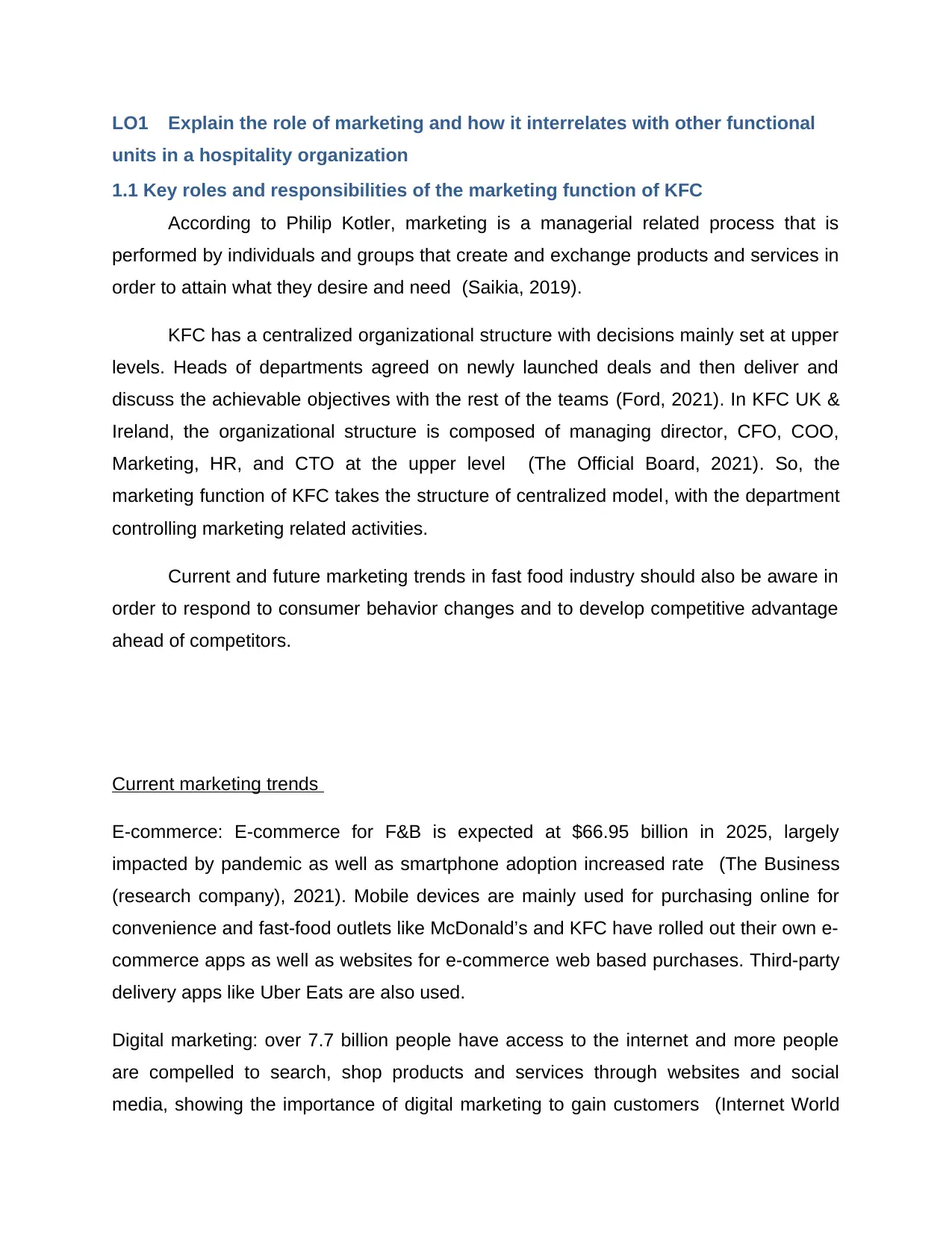
LO1 Explain the role of marketing and how it interrelates with other functional
units in a hospitality organization
1.1 Key roles and responsibilities of the marketing function of KFC
According to Philip Kotler, marketing is a managerial related process that is
performed by individuals and groups that create and exchange products and services in
order to attain what they desire and need (Saikia, 2019).
KFC has a centralized organizational structure with decisions mainly set at upper
levels. Heads of departments agreed on newly launched deals and then deliver and
discuss the achievable objectives with the rest of the teams (Ford, 2021). In KFC UK &
Ireland, the organizational structure is composed of managing director, CFO, COO,
Marketing, HR, and CTO at the upper level (The Official Board, 2021). So, the
marketing function of KFC takes the structure of centralized model, with the department
controlling marketing related activities.
Current and future marketing trends in fast food industry should also be aware in
order to respond to consumer behavior changes and to develop competitive advantage
ahead of competitors.
Current marketing trends
E-commerce: E-commerce for F&B is expected at $66.95 billion in 2025, largely
impacted by pandemic as well as smartphone adoption increased rate (The Business
(research company), 2021). Mobile devices are mainly used for purchasing online for
convenience and fast-food outlets like McDonald’s and KFC have rolled out their own e-
commerce apps as well as websites for e-commerce web based purchases. Third-party
delivery apps like Uber Eats are also used.
Digital marketing: over 7.7 billion people have access to the internet and more people
are compelled to search, shop products and services through websites and social
media, showing the importance of digital marketing to gain customers (Internet World
units in a hospitality organization
1.1 Key roles and responsibilities of the marketing function of KFC
According to Philip Kotler, marketing is a managerial related process that is
performed by individuals and groups that create and exchange products and services in
order to attain what they desire and need (Saikia, 2019).
KFC has a centralized organizational structure with decisions mainly set at upper
levels. Heads of departments agreed on newly launched deals and then deliver and
discuss the achievable objectives with the rest of the teams (Ford, 2021). In KFC UK &
Ireland, the organizational structure is composed of managing director, CFO, COO,
Marketing, HR, and CTO at the upper level (The Official Board, 2021). So, the
marketing function of KFC takes the structure of centralized model, with the department
controlling marketing related activities.
Current and future marketing trends in fast food industry should also be aware in
order to respond to consumer behavior changes and to develop competitive advantage
ahead of competitors.
Current marketing trends
E-commerce: E-commerce for F&B is expected at $66.95 billion in 2025, largely
impacted by pandemic as well as smartphone adoption increased rate (The Business
(research company), 2021). Mobile devices are mainly used for purchasing online for
convenience and fast-food outlets like McDonald’s and KFC have rolled out their own e-
commerce apps as well as websites for e-commerce web based purchases. Third-party
delivery apps like Uber Eats are also used.
Digital marketing: over 7.7 billion people have access to the internet and more people
are compelled to search, shop products and services through websites and social
media, showing the importance of digital marketing to gain customers (Internet World
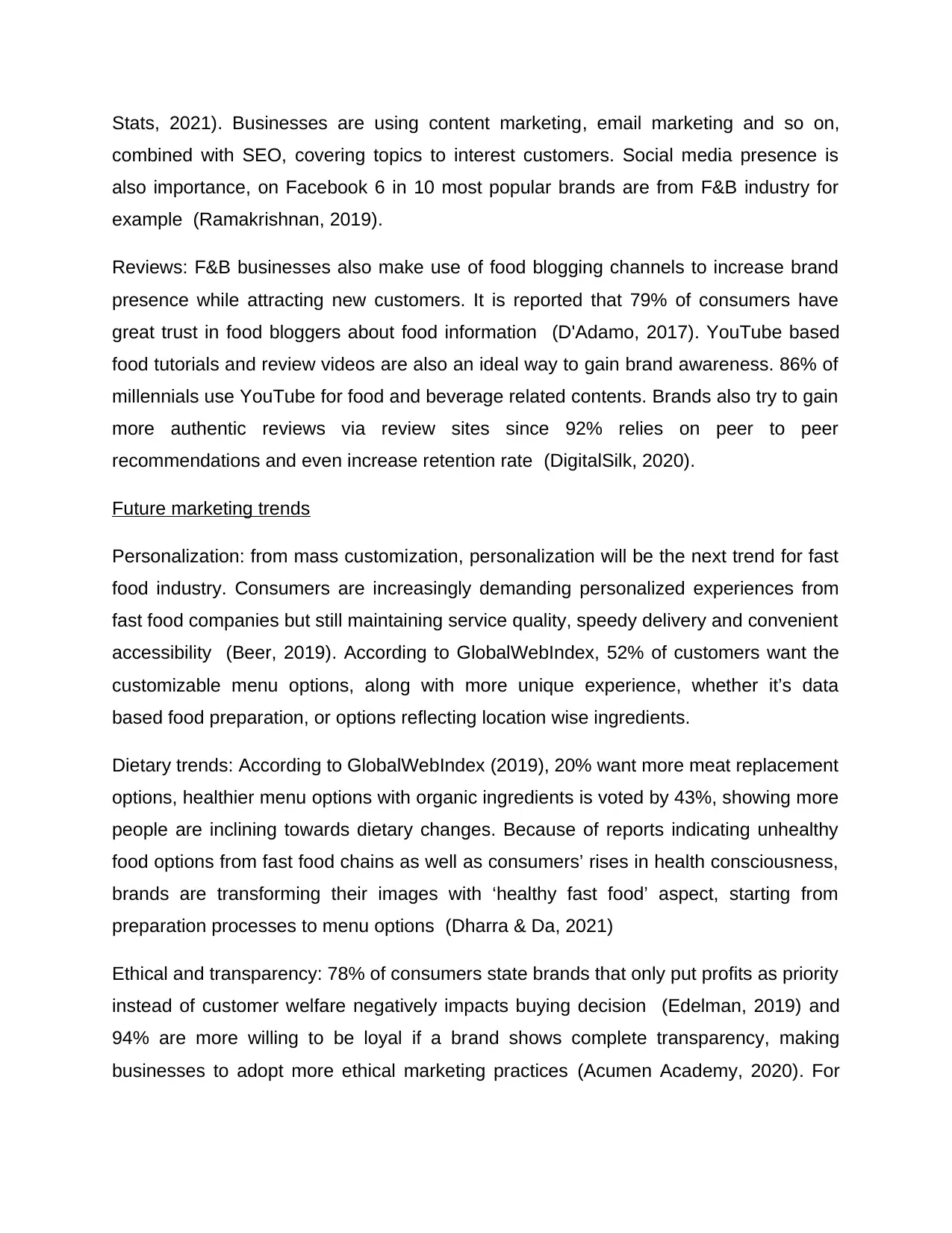
Stats, 2021). Businesses are using content marketing, email marketing and so on,
combined with SEO, covering topics to interest customers. Social media presence is
also importance, on Facebook 6 in 10 most popular brands are from F&B industry for
example (Ramakrishnan, 2019).
Reviews: F&B businesses also make use of food blogging channels to increase brand
presence while attracting new customers. It is reported that 79% of consumers have
great trust in food bloggers about food information (D'Adamo, 2017). YouTube based
food tutorials and review videos are also an ideal way to gain brand awareness. 86% of
millennials use YouTube for food and beverage related contents. Brands also try to gain
more authentic reviews via review sites since 92% relies on peer to peer
recommendations and even increase retention rate (DigitalSilk, 2020).
Future marketing trends
Personalization: from mass customization, personalization will be the next trend for fast
food industry. Consumers are increasingly demanding personalized experiences from
fast food companies but still maintaining service quality, speedy delivery and convenient
accessibility (Beer, 2019). According to GlobalWebIndex, 52% of customers want the
customizable menu options, along with more unique experience, whether it’s data
based food preparation, or options reflecting location wise ingredients.
Dietary trends: According to GlobalWebIndex (2019), 20% want more meat replacement
options, healthier menu options with organic ingredients is voted by 43%, showing more
people are inclining towards dietary changes. Because of reports indicating unhealthy
food options from fast food chains as well as consumers’ rises in health consciousness,
brands are transforming their images with ‘healthy fast food’ aspect, starting from
preparation processes to menu options (Dharra & Da, 2021)
Ethical and transparency: 78% of consumers state brands that only put profits as priority
instead of customer welfare negatively impacts buying decision (Edelman, 2019) and
94% are more willing to be loyal if a brand shows complete transparency, making
businesses to adopt more ethical marketing practices (Acumen Academy, 2020). For
combined with SEO, covering topics to interest customers. Social media presence is
also importance, on Facebook 6 in 10 most popular brands are from F&B industry for
example (Ramakrishnan, 2019).
Reviews: F&B businesses also make use of food blogging channels to increase brand
presence while attracting new customers. It is reported that 79% of consumers have
great trust in food bloggers about food information (D'Adamo, 2017). YouTube based
food tutorials and review videos are also an ideal way to gain brand awareness. 86% of
millennials use YouTube for food and beverage related contents. Brands also try to gain
more authentic reviews via review sites since 92% relies on peer to peer
recommendations and even increase retention rate (DigitalSilk, 2020).
Future marketing trends
Personalization: from mass customization, personalization will be the next trend for fast
food industry. Consumers are increasingly demanding personalized experiences from
fast food companies but still maintaining service quality, speedy delivery and convenient
accessibility (Beer, 2019). According to GlobalWebIndex, 52% of customers want the
customizable menu options, along with more unique experience, whether it’s data
based food preparation, or options reflecting location wise ingredients.
Dietary trends: According to GlobalWebIndex (2019), 20% want more meat replacement
options, healthier menu options with organic ingredients is voted by 43%, showing more
people are inclining towards dietary changes. Because of reports indicating unhealthy
food options from fast food chains as well as consumers’ rises in health consciousness,
brands are transforming their images with ‘healthy fast food’ aspect, starting from
preparation processes to menu options (Dharra & Da, 2021)
Ethical and transparency: 78% of consumers state brands that only put profits as priority
instead of customer welfare negatively impacts buying decision (Edelman, 2019) and
94% are more willing to be loyal if a brand shows complete transparency, making
businesses to adopt more ethical marketing practices (Acumen Academy, 2020). For
⊘ This is a preview!⊘
Do you want full access?
Subscribe today to unlock all pages.

Trusted by 1+ million students worldwide
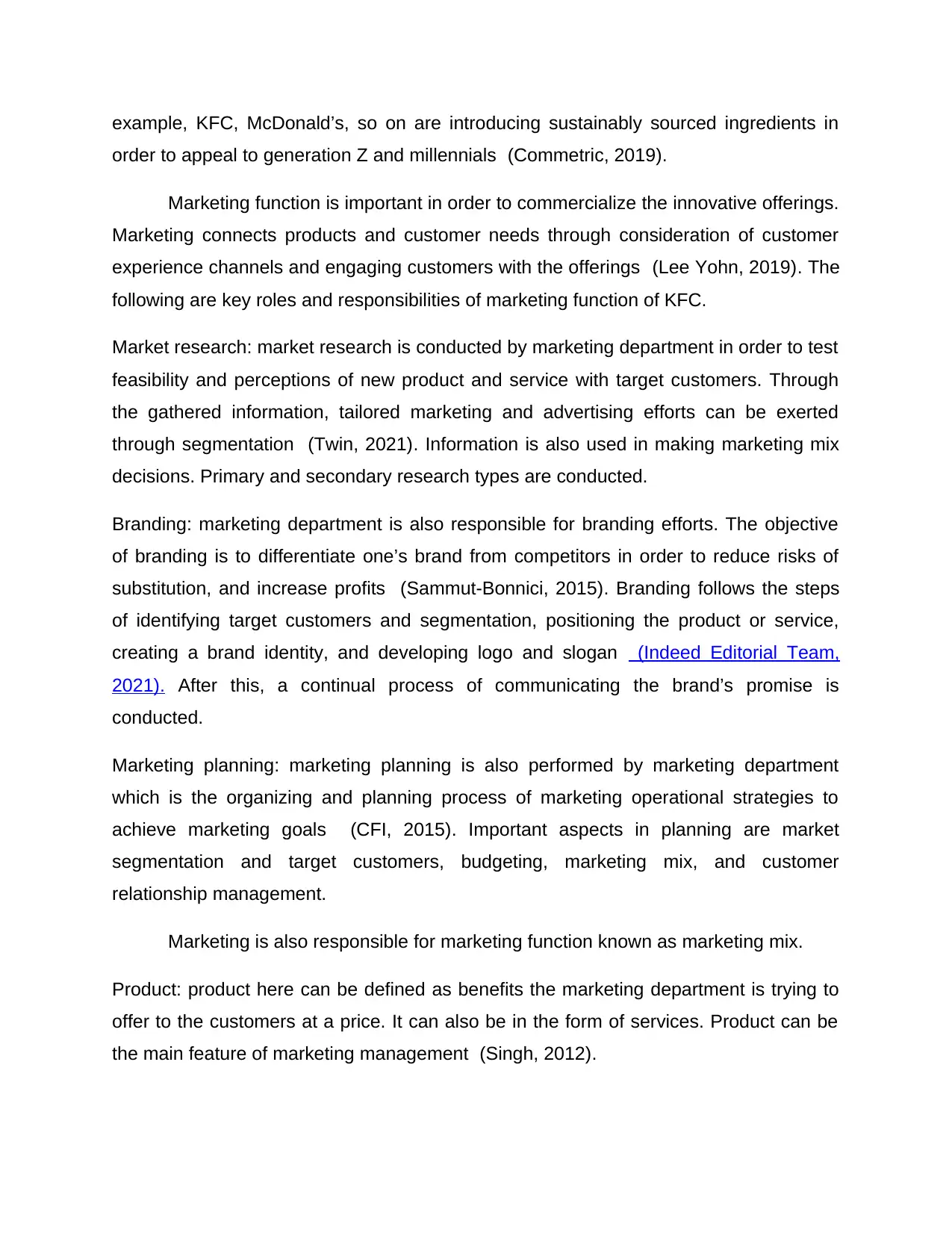
example, KFC, McDonald’s, so on are introducing sustainably sourced ingredients in
order to appeal to generation Z and millennials (Commetric, 2019).
Marketing function is important in order to commercialize the innovative offerings.
Marketing connects products and customer needs through consideration of customer
experience channels and engaging customers with the offerings (Lee Yohn, 2019). The
following are key roles and responsibilities of marketing function of KFC.
Market research: market research is conducted by marketing department in order to test
feasibility and perceptions of new product and service with target customers. Through
the gathered information, tailored marketing and advertising efforts can be exerted
through segmentation (Twin, 2021). Information is also used in making marketing mix
decisions. Primary and secondary research types are conducted.
Branding: marketing department is also responsible for branding efforts. The objective
of branding is to differentiate one’s brand from competitors in order to reduce risks of
substitution, and increase profits (Sammut-Bonnici, 2015). Branding follows the steps
of identifying target customers and segmentation, positioning the product or service,
creating a brand identity, and developing logo and slogan (Indeed Editorial Team,
2021). After this, a continual process of communicating the brand’s promise is
conducted.
Marketing planning: marketing planning is also performed by marketing department
which is the organizing and planning process of marketing operational strategies to
achieve marketing goals (CFI, 2015). Important aspects in planning are market
segmentation and target customers, budgeting, marketing mix, and customer
relationship management.
Marketing is also responsible for marketing function known as marketing mix.
Product: product here can be defined as benefits the marketing department is trying to
offer to the customers at a price. It can also be in the form of services. Product can be
the main feature of marketing management (Singh, 2012).
order to appeal to generation Z and millennials (Commetric, 2019).
Marketing function is important in order to commercialize the innovative offerings.
Marketing connects products and customer needs through consideration of customer
experience channels and engaging customers with the offerings (Lee Yohn, 2019). The
following are key roles and responsibilities of marketing function of KFC.
Market research: market research is conducted by marketing department in order to test
feasibility and perceptions of new product and service with target customers. Through
the gathered information, tailored marketing and advertising efforts can be exerted
through segmentation (Twin, 2021). Information is also used in making marketing mix
decisions. Primary and secondary research types are conducted.
Branding: marketing department is also responsible for branding efforts. The objective
of branding is to differentiate one’s brand from competitors in order to reduce risks of
substitution, and increase profits (Sammut-Bonnici, 2015). Branding follows the steps
of identifying target customers and segmentation, positioning the product or service,
creating a brand identity, and developing logo and slogan (Indeed Editorial Team,
2021). After this, a continual process of communicating the brand’s promise is
conducted.
Marketing planning: marketing planning is also performed by marketing department
which is the organizing and planning process of marketing operational strategies to
achieve marketing goals (CFI, 2015). Important aspects in planning are market
segmentation and target customers, budgeting, marketing mix, and customer
relationship management.
Marketing is also responsible for marketing function known as marketing mix.
Product: product here can be defined as benefits the marketing department is trying to
offer to the customers at a price. It can also be in the form of services. Product can be
the main feature of marketing management (Singh, 2012).
Paraphrase This Document
Need a fresh take? Get an instant paraphrase of this document with our AI Paraphraser
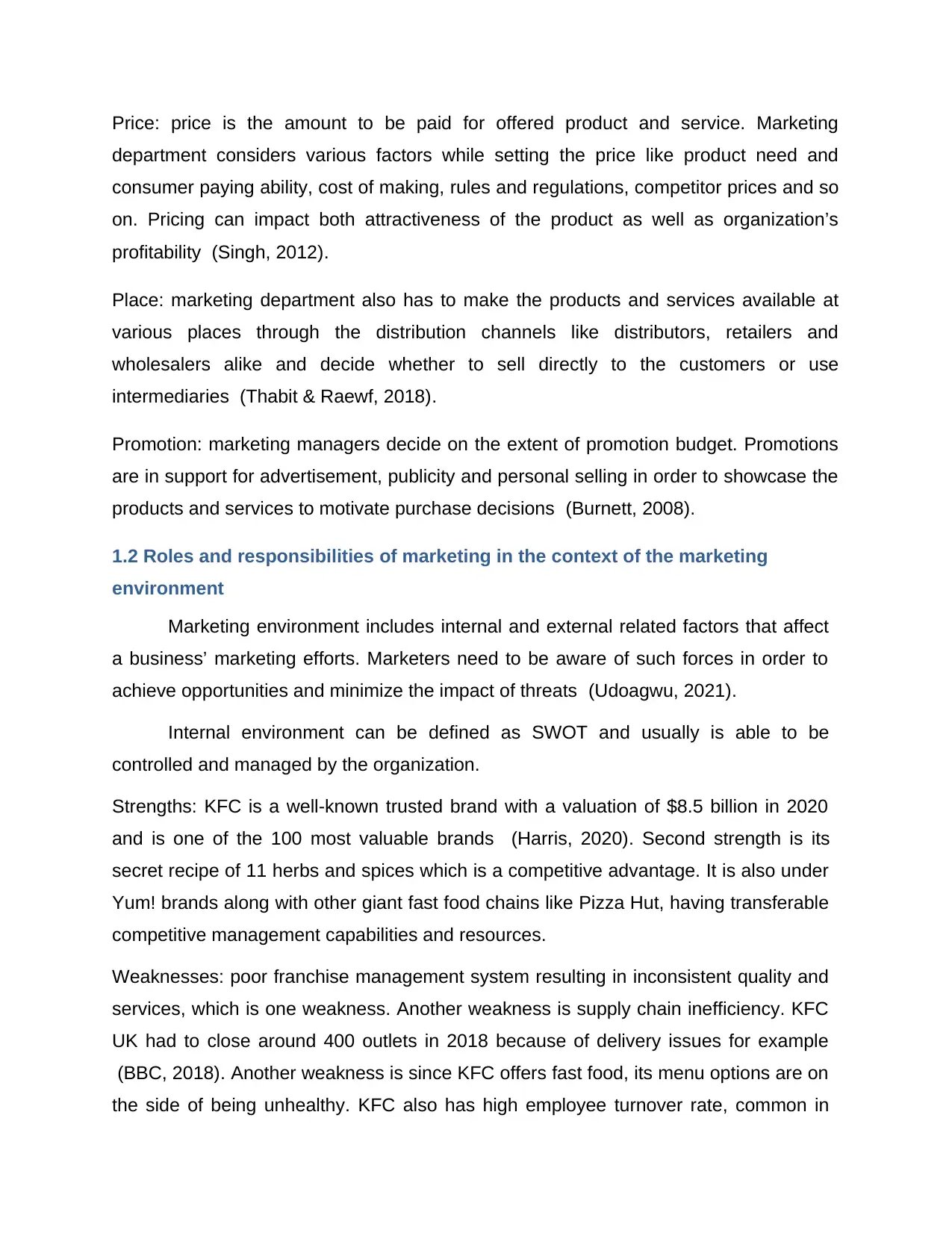
Price: price is the amount to be paid for offered product and service. Marketing
department considers various factors while setting the price like product need and
consumer paying ability, cost of making, rules and regulations, competitor prices and so
on. Pricing can impact both attractiveness of the product as well as organization’s
profitability (Singh, 2012).
Place: marketing department also has to make the products and services available at
various places through the distribution channels like distributors, retailers and
wholesalers alike and decide whether to sell directly to the customers or use
intermediaries (Thabit & Raewf, 2018).
Promotion: marketing managers decide on the extent of promotion budget. Promotions
are in support for advertisement, publicity and personal selling in order to showcase the
products and services to motivate purchase decisions (Burnett, 2008).
1.2 Roles and responsibilities of marketing in the context of the marketing
environment
Marketing environment includes internal and external related factors that affect
a business’ marketing efforts. Marketers need to be aware of such forces in order to
achieve opportunities and minimize the impact of threats (Udoagwu, 2021).
Internal environment can be defined as SWOT and usually is able to be
controlled and managed by the organization.
Strengths: KFC is a well-known trusted brand with a valuation of $8.5 billion in 2020
and is one of the 100 most valuable brands (Harris, 2020). Second strength is its
secret recipe of 11 herbs and spices which is a competitive advantage. It is also under
Yum! brands along with other giant fast food chains like Pizza Hut, having transferable
competitive management capabilities and resources.
Weaknesses: poor franchise management system resulting in inconsistent quality and
services, which is one weakness. Another weakness is supply chain inefficiency. KFC
UK had to close around 400 outlets in 2018 because of delivery issues for example
(BBC, 2018). Another weakness is since KFC offers fast food, its menu options are on
the side of being unhealthy. KFC also has high employee turnover rate, common in
department considers various factors while setting the price like product need and
consumer paying ability, cost of making, rules and regulations, competitor prices and so
on. Pricing can impact both attractiveness of the product as well as organization’s
profitability (Singh, 2012).
Place: marketing department also has to make the products and services available at
various places through the distribution channels like distributors, retailers and
wholesalers alike and decide whether to sell directly to the customers or use
intermediaries (Thabit & Raewf, 2018).
Promotion: marketing managers decide on the extent of promotion budget. Promotions
are in support for advertisement, publicity and personal selling in order to showcase the
products and services to motivate purchase decisions (Burnett, 2008).
1.2 Roles and responsibilities of marketing in the context of the marketing
environment
Marketing environment includes internal and external related factors that affect
a business’ marketing efforts. Marketers need to be aware of such forces in order to
achieve opportunities and minimize the impact of threats (Udoagwu, 2021).
Internal environment can be defined as SWOT and usually is able to be
controlled and managed by the organization.
Strengths: KFC is a well-known trusted brand with a valuation of $8.5 billion in 2020
and is one of the 100 most valuable brands (Harris, 2020). Second strength is its
secret recipe of 11 herbs and spices which is a competitive advantage. It is also under
Yum! brands along with other giant fast food chains like Pizza Hut, having transferable
competitive management capabilities and resources.
Weaknesses: poor franchise management system resulting in inconsistent quality and
services, which is one weakness. Another weakness is supply chain inefficiency. KFC
UK had to close around 400 outlets in 2018 because of delivery issues for example
(BBC, 2018). Another weakness is since KFC offers fast food, its menu options are on
the side of being unhealthy. KFC also has high employee turnover rate, common in
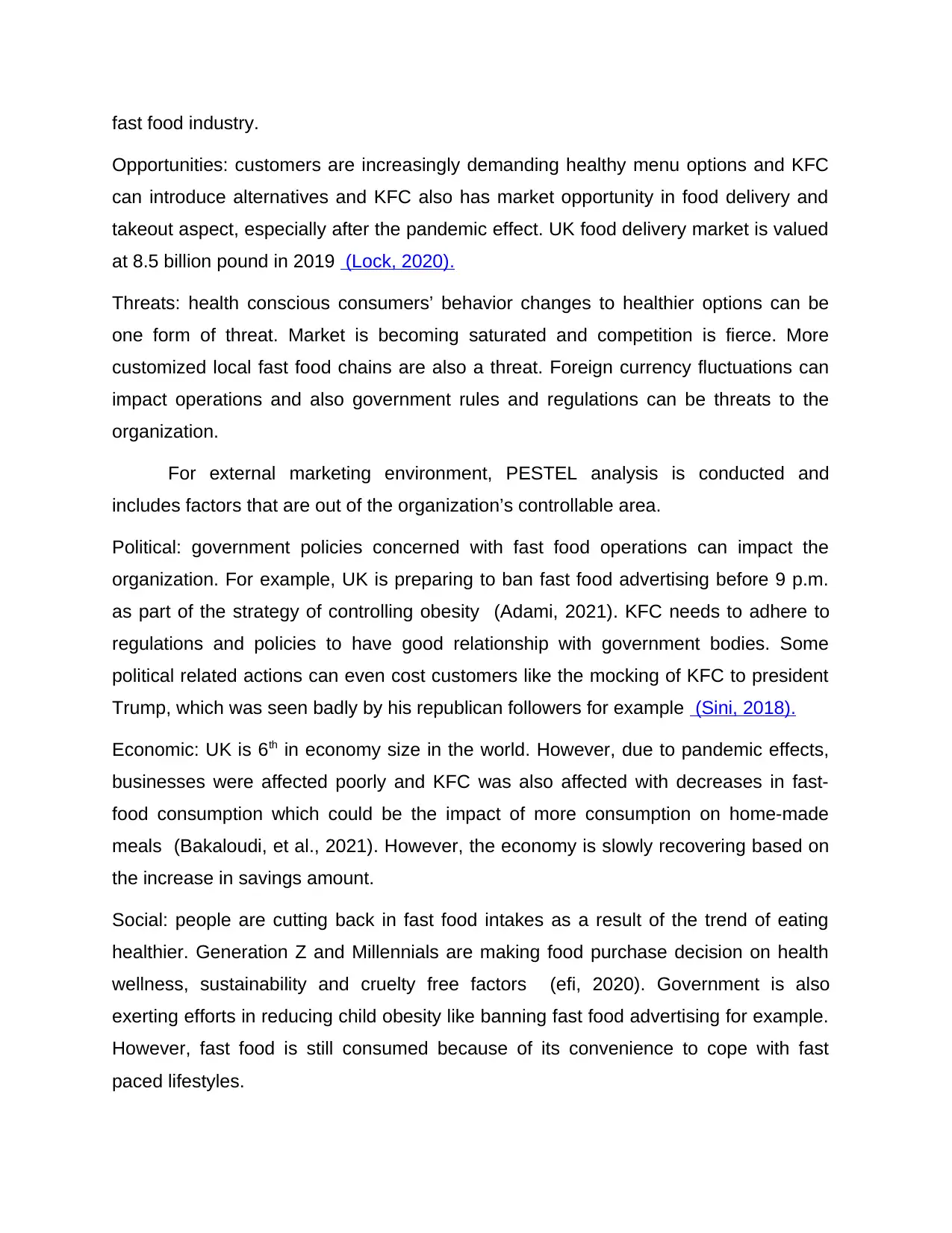
fast food industry.
Opportunities: customers are increasingly demanding healthy menu options and KFC
can introduce alternatives and KFC also has market opportunity in food delivery and
takeout aspect, especially after the pandemic effect. UK food delivery market is valued
at 8.5 billion pound in 2019 (Lock, 2020).
Threats: health conscious consumers’ behavior changes to healthier options can be
one form of threat. Market is becoming saturated and competition is fierce. More
customized local fast food chains are also a threat. Foreign currency fluctuations can
impact operations and also government rules and regulations can be threats to the
organization.
For external marketing environment, PESTEL analysis is conducted and
includes factors that are out of the organization’s controllable area.
Political: government policies concerned with fast food operations can impact the
organization. For example, UK is preparing to ban fast food advertising before 9 p.m.
as part of the strategy of controlling obesity (Adami, 2021). KFC needs to adhere to
regulations and policies to have good relationship with government bodies. Some
political related actions can even cost customers like the mocking of KFC to president
Trump, which was seen badly by his republican followers for example (Sini, 2018).
Economic: UK is 6th in economy size in the world. However, due to pandemic effects,
businesses were affected poorly and KFC was also affected with decreases in fast-
food consumption which could be the impact of more consumption on home-made
meals (Bakaloudi, et al., 2021). However, the economy is slowly recovering based on
the increase in savings amount.
Social: people are cutting back in fast food intakes as a result of the trend of eating
healthier. Generation Z and Millennials are making food purchase decision on health
wellness, sustainability and cruelty free factors (efi, 2020). Government is also
exerting efforts in reducing child obesity like banning fast food advertising for example.
However, fast food is still consumed because of its convenience to cope with fast
paced lifestyles.
Opportunities: customers are increasingly demanding healthy menu options and KFC
can introduce alternatives and KFC also has market opportunity in food delivery and
takeout aspect, especially after the pandemic effect. UK food delivery market is valued
at 8.5 billion pound in 2019 (Lock, 2020).
Threats: health conscious consumers’ behavior changes to healthier options can be
one form of threat. Market is becoming saturated and competition is fierce. More
customized local fast food chains are also a threat. Foreign currency fluctuations can
impact operations and also government rules and regulations can be threats to the
organization.
For external marketing environment, PESTEL analysis is conducted and
includes factors that are out of the organization’s controllable area.
Political: government policies concerned with fast food operations can impact the
organization. For example, UK is preparing to ban fast food advertising before 9 p.m.
as part of the strategy of controlling obesity (Adami, 2021). KFC needs to adhere to
regulations and policies to have good relationship with government bodies. Some
political related actions can even cost customers like the mocking of KFC to president
Trump, which was seen badly by his republican followers for example (Sini, 2018).
Economic: UK is 6th in economy size in the world. However, due to pandemic effects,
businesses were affected poorly and KFC was also affected with decreases in fast-
food consumption which could be the impact of more consumption on home-made
meals (Bakaloudi, et al., 2021). However, the economy is slowly recovering based on
the increase in savings amount.
Social: people are cutting back in fast food intakes as a result of the trend of eating
healthier. Generation Z and Millennials are making food purchase decision on health
wellness, sustainability and cruelty free factors (efi, 2020). Government is also
exerting efforts in reducing child obesity like banning fast food advertising for example.
However, fast food is still consumed because of its convenience to cope with fast
paced lifestyles.
⊘ This is a preview!⊘
Do you want full access?
Subscribe today to unlock all pages.

Trusted by 1+ million students worldwide
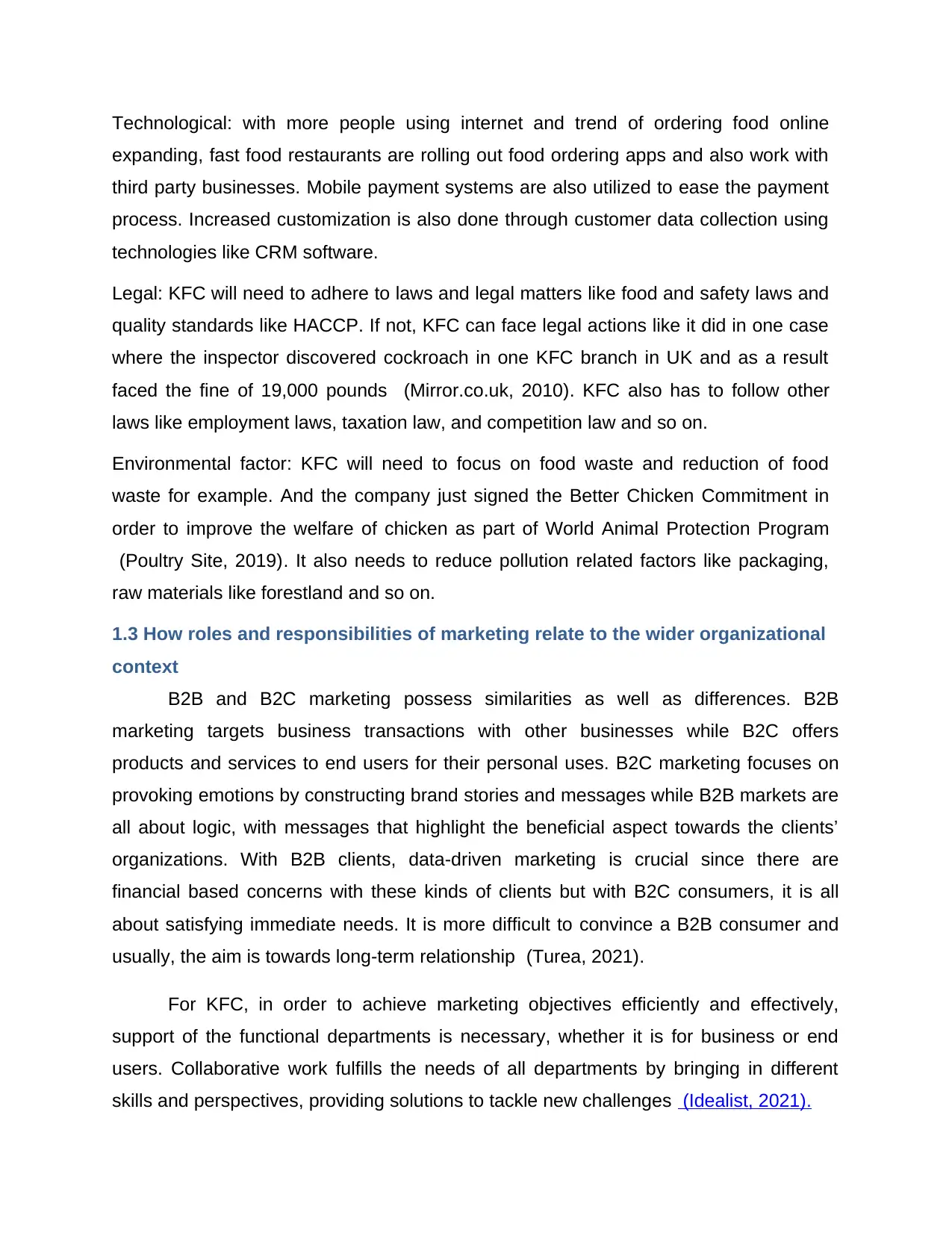
Technological: with more people using internet and trend of ordering food online
expanding, fast food restaurants are rolling out food ordering apps and also work with
third party businesses. Mobile payment systems are also utilized to ease the payment
process. Increased customization is also done through customer data collection using
technologies like CRM software.
Legal: KFC will need to adhere to laws and legal matters like food and safety laws and
quality standards like HACCP. If not, KFC can face legal actions like it did in one case
where the inspector discovered cockroach in one KFC branch in UK and as a result
faced the fine of 19,000 pounds (Mirror.co.uk, 2010). KFC also has to follow other
laws like employment laws, taxation law, and competition law and so on.
Environmental factor: KFC will need to focus on food waste and reduction of food
waste for example. And the company just signed the Better Chicken Commitment in
order to improve the welfare of chicken as part of World Animal Protection Program
(Poultry Site, 2019). It also needs to reduce pollution related factors like packaging,
raw materials like forestland and so on.
1.3 How roles and responsibilities of marketing relate to the wider organizational
context
B2B and B2C marketing possess similarities as well as differences. B2B
marketing targets business transactions with other businesses while B2C offers
products and services to end users for their personal uses. B2C marketing focuses on
provoking emotions by constructing brand stories and messages while B2B markets are
all about logic, with messages that highlight the beneficial aspect towards the clients’
organizations. With B2B clients, data-driven marketing is crucial since there are
financial based concerns with these kinds of clients but with B2C consumers, it is all
about satisfying immediate needs. It is more difficult to convince a B2B consumer and
usually, the aim is towards long-term relationship (Turea, 2021).
For KFC, in order to achieve marketing objectives efficiently and effectively,
support of the functional departments is necessary, whether it is for business or end
users. Collaborative work fulfills the needs of all departments by bringing in different
skills and perspectives, providing solutions to tackle new challenges (Idealist, 2021).
expanding, fast food restaurants are rolling out food ordering apps and also work with
third party businesses. Mobile payment systems are also utilized to ease the payment
process. Increased customization is also done through customer data collection using
technologies like CRM software.
Legal: KFC will need to adhere to laws and legal matters like food and safety laws and
quality standards like HACCP. If not, KFC can face legal actions like it did in one case
where the inspector discovered cockroach in one KFC branch in UK and as a result
faced the fine of 19,000 pounds (Mirror.co.uk, 2010). KFC also has to follow other
laws like employment laws, taxation law, and competition law and so on.
Environmental factor: KFC will need to focus on food waste and reduction of food
waste for example. And the company just signed the Better Chicken Commitment in
order to improve the welfare of chicken as part of World Animal Protection Program
(Poultry Site, 2019). It also needs to reduce pollution related factors like packaging,
raw materials like forestland and so on.
1.3 How roles and responsibilities of marketing relate to the wider organizational
context
B2B and B2C marketing possess similarities as well as differences. B2B
marketing targets business transactions with other businesses while B2C offers
products and services to end users for their personal uses. B2C marketing focuses on
provoking emotions by constructing brand stories and messages while B2B markets are
all about logic, with messages that highlight the beneficial aspect towards the clients’
organizations. With B2B clients, data-driven marketing is crucial since there are
financial based concerns with these kinds of clients but with B2C consumers, it is all
about satisfying immediate needs. It is more difficult to convince a B2B consumer and
usually, the aim is towards long-term relationship (Turea, 2021).
For KFC, in order to achieve marketing objectives efficiently and effectively,
support of the functional departments is necessary, whether it is for business or end
users. Collaborative work fulfills the needs of all departments by bringing in different
skills and perspectives, providing solutions to tackle new challenges (Idealist, 2021).
Paraphrase This Document
Need a fresh take? Get an instant paraphrase of this document with our AI Paraphraser
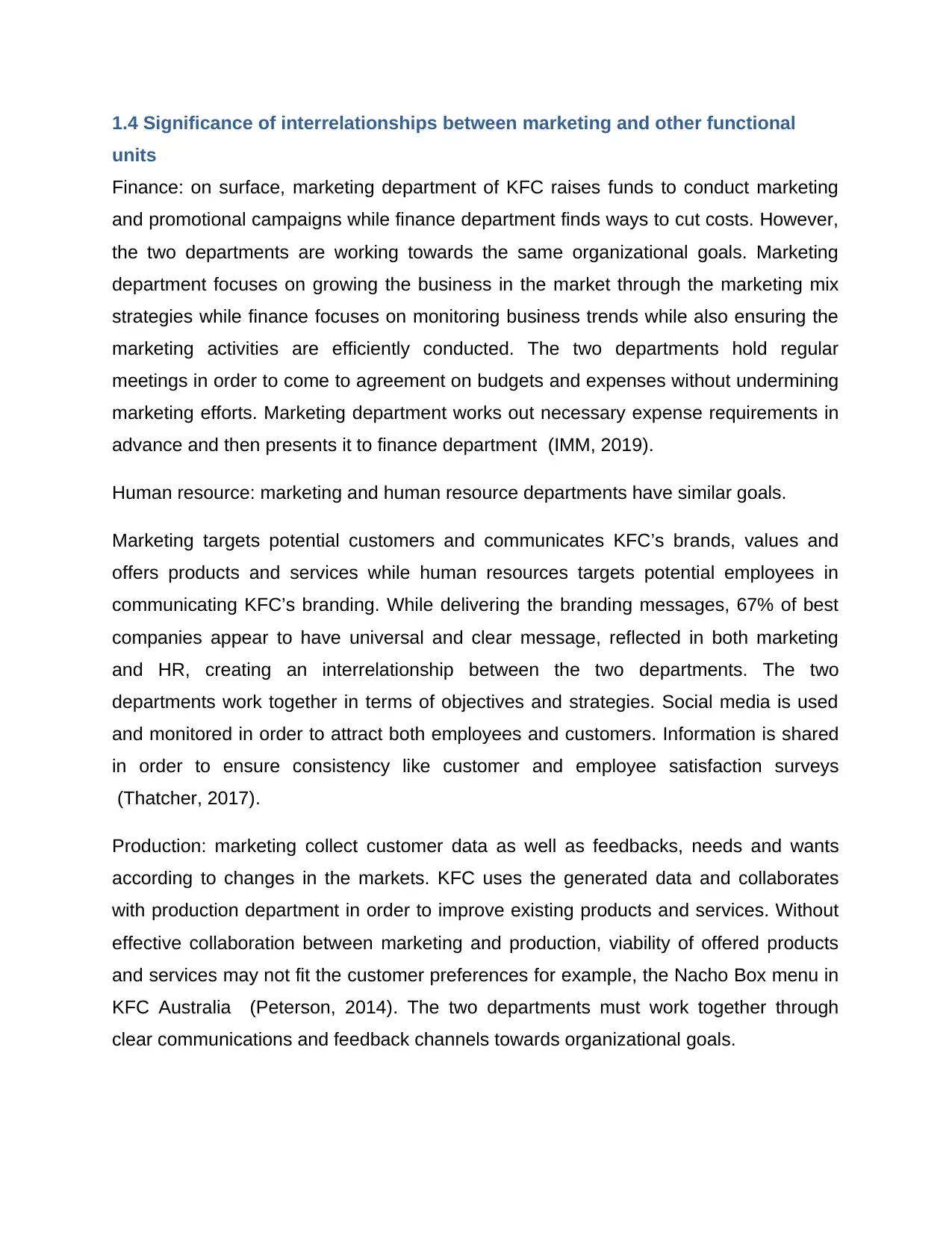
1.4 Significance of interrelationships between marketing and other functional
units
Finance: on surface, marketing department of KFC raises funds to conduct marketing
and promotional campaigns while finance department finds ways to cut costs. However,
the two departments are working towards the same organizational goals. Marketing
department focuses on growing the business in the market through the marketing mix
strategies while finance focuses on monitoring business trends while also ensuring the
marketing activities are efficiently conducted. The two departments hold regular
meetings in order to come to agreement on budgets and expenses without undermining
marketing efforts. Marketing department works out necessary expense requirements in
advance and then presents it to finance department (IMM, 2019).
Human resource: marketing and human resource departments have similar goals.
Marketing targets potential customers and communicates KFC’s brands, values and
offers products and services while human resources targets potential employees in
communicating KFC’s branding. While delivering the branding messages, 67% of best
companies appear to have universal and clear message, reflected in both marketing
and HR, creating an interrelationship between the two departments. The two
departments work together in terms of objectives and strategies. Social media is used
and monitored in order to attract both employees and customers. Information is shared
in order to ensure consistency like customer and employee satisfaction surveys
(Thatcher, 2017).
Production: marketing collect customer data as well as feedbacks, needs and wants
according to changes in the markets. KFC uses the generated data and collaborates
with production department in order to improve existing products and services. Without
effective collaboration between marketing and production, viability of offered products
and services may not fit the customer preferences for example, the Nacho Box menu in
KFC Australia (Peterson, 2014). The two departments must work together through
clear communications and feedback channels towards organizational goals.
units
Finance: on surface, marketing department of KFC raises funds to conduct marketing
and promotional campaigns while finance department finds ways to cut costs. However,
the two departments are working towards the same organizational goals. Marketing
department focuses on growing the business in the market through the marketing mix
strategies while finance focuses on monitoring business trends while also ensuring the
marketing activities are efficiently conducted. The two departments hold regular
meetings in order to come to agreement on budgets and expenses without undermining
marketing efforts. Marketing department works out necessary expense requirements in
advance and then presents it to finance department (IMM, 2019).
Human resource: marketing and human resource departments have similar goals.
Marketing targets potential customers and communicates KFC’s brands, values and
offers products and services while human resources targets potential employees in
communicating KFC’s branding. While delivering the branding messages, 67% of best
companies appear to have universal and clear message, reflected in both marketing
and HR, creating an interrelationship between the two departments. The two
departments work together in terms of objectives and strategies. Social media is used
and monitored in order to attract both employees and customers. Information is shared
in order to ensure consistency like customer and employee satisfaction surveys
(Thatcher, 2017).
Production: marketing collect customer data as well as feedbacks, needs and wants
according to changes in the markets. KFC uses the generated data and collaborates
with production department in order to improve existing products and services. Without
effective collaboration between marketing and production, viability of offered products
and services may not fit the customer preferences for example, the Nacho Box menu in
KFC Australia (Peterson, 2014). The two departments must work together through
clear communications and feedback channels towards organizational goals.
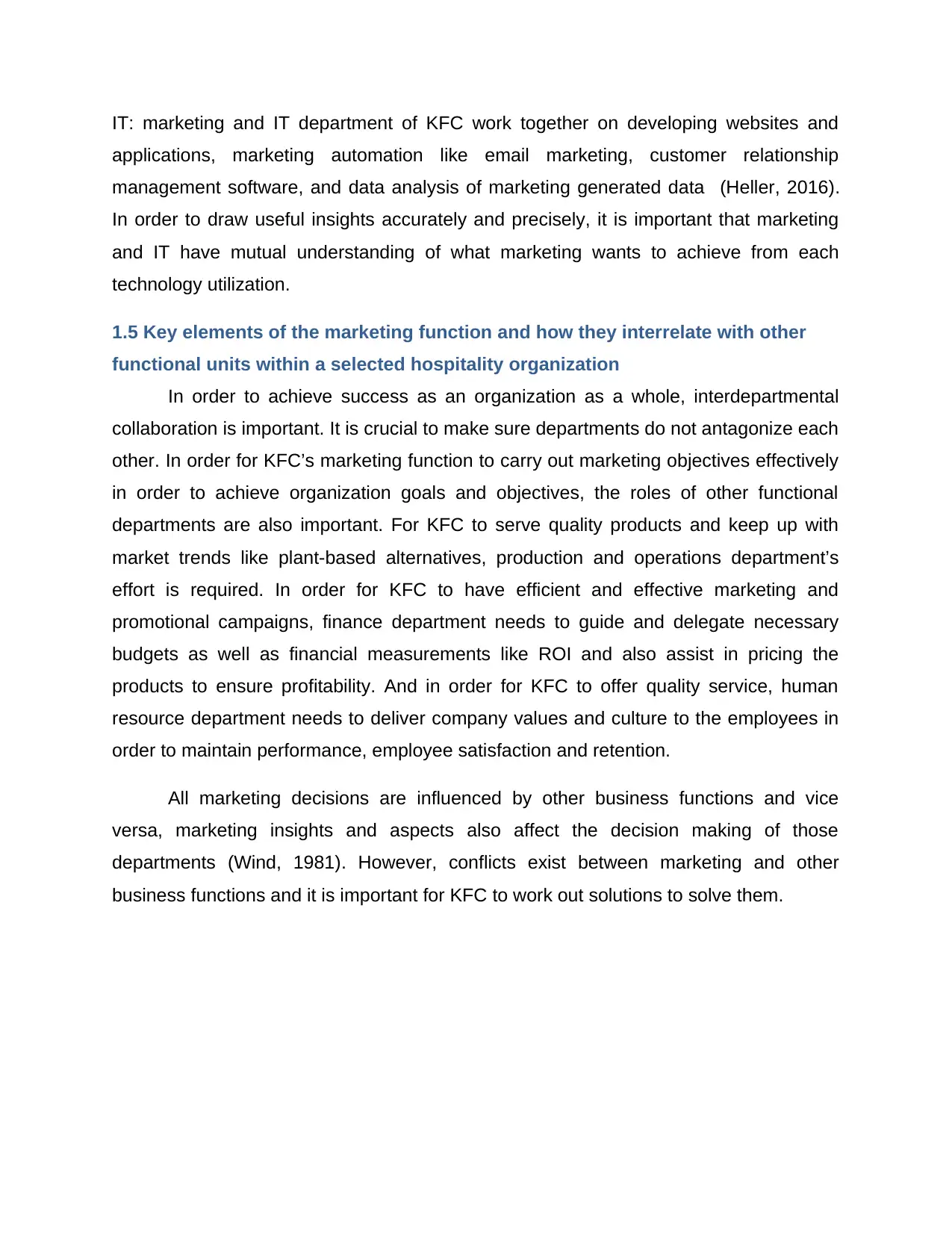
IT: marketing and IT department of KFC work together on developing websites and
applications, marketing automation like email marketing, customer relationship
management software, and data analysis of marketing generated data (Heller, 2016).
In order to draw useful insights accurately and precisely, it is important that marketing
and IT have mutual understanding of what marketing wants to achieve from each
technology utilization.
1.5 Key elements of the marketing function and how they interrelate with other
functional units within a selected hospitality organization
In order to achieve success as an organization as a whole, interdepartmental
collaboration is important. It is crucial to make sure departments do not antagonize each
other. In order for KFC’s marketing function to carry out marketing objectives effectively
in order to achieve organization goals and objectives, the roles of other functional
departments are also important. For KFC to serve quality products and keep up with
market trends like plant-based alternatives, production and operations department’s
effort is required. In order for KFC to have efficient and effective marketing and
promotional campaigns, finance department needs to guide and delegate necessary
budgets as well as financial measurements like ROI and also assist in pricing the
products to ensure profitability. And in order for KFC to offer quality service, human
resource department needs to deliver company values and culture to the employees in
order to maintain performance, employee satisfaction and retention.
All marketing decisions are influenced by other business functions and vice
versa, marketing insights and aspects also affect the decision making of those
departments (Wind, 1981). However, conflicts exist between marketing and other
business functions and it is important for KFC to work out solutions to solve them.
applications, marketing automation like email marketing, customer relationship
management software, and data analysis of marketing generated data (Heller, 2016).
In order to draw useful insights accurately and precisely, it is important that marketing
and IT have mutual understanding of what marketing wants to achieve from each
technology utilization.
1.5 Key elements of the marketing function and how they interrelate with other
functional units within a selected hospitality organization
In order to achieve success as an organization as a whole, interdepartmental
collaboration is important. It is crucial to make sure departments do not antagonize each
other. In order for KFC’s marketing function to carry out marketing objectives effectively
in order to achieve organization goals and objectives, the roles of other functional
departments are also important. For KFC to serve quality products and keep up with
market trends like plant-based alternatives, production and operations department’s
effort is required. In order for KFC to have efficient and effective marketing and
promotional campaigns, finance department needs to guide and delegate necessary
budgets as well as financial measurements like ROI and also assist in pricing the
products to ensure profitability. And in order for KFC to offer quality service, human
resource department needs to deliver company values and culture to the employees in
order to maintain performance, employee satisfaction and retention.
All marketing decisions are influenced by other business functions and vice
versa, marketing insights and aspects also affect the decision making of those
departments (Wind, 1981). However, conflicts exist between marketing and other
business functions and it is important for KFC to work out solutions to solve them.
⊘ This is a preview!⊘
Do you want full access?
Subscribe today to unlock all pages.

Trusted by 1+ million students worldwide
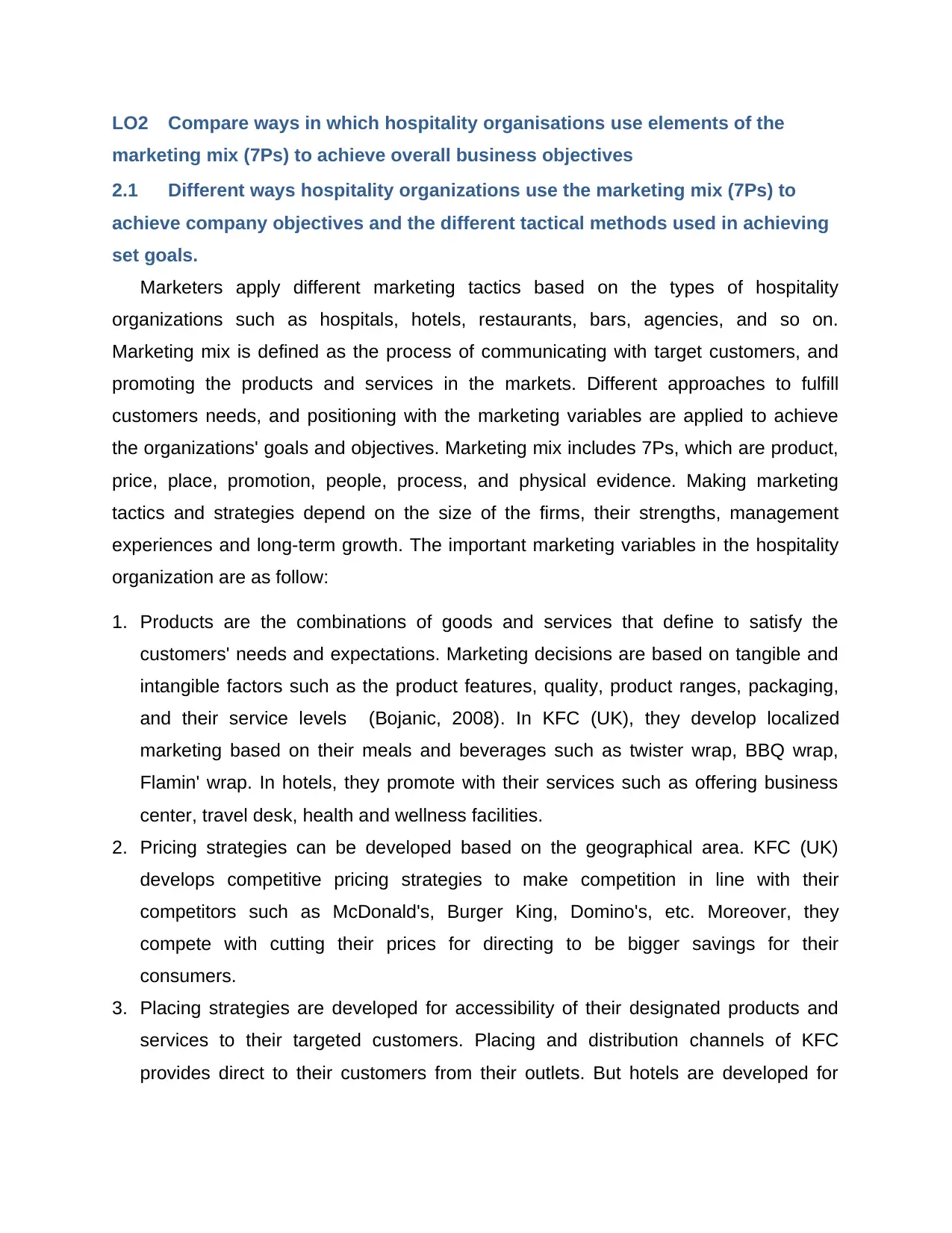
LO2 Compare ways in which hospitality organisations use elements of the
marketing mix (7Ps) to achieve overall business objectives
2.1 Different ways hospitality organizations use the marketing mix (7Ps) to
achieve company objectives and the different tactical methods used in achieving
set goals.
Marketers apply different marketing tactics based on the types of hospitality
organizations such as hospitals, hotels, restaurants, bars, agencies, and so on.
Marketing mix is defined as the process of communicating with target customers, and
promoting the products and services in the markets. Different approaches to fulfill
customers needs, and positioning with the marketing variables are applied to achieve
the organizations' goals and objectives. Marketing mix includes 7Ps, which are product,
price, place, promotion, people, process, and physical evidence. Making marketing
tactics and strategies depend on the size of the firms, their strengths, management
experiences and long-term growth. The important marketing variables in the hospitality
organization are as follow:
1. Products are the combinations of goods and services that define to satisfy the
customers' needs and expectations. Marketing decisions are based on tangible and
intangible factors such as the product features, quality, product ranges, packaging,
and their service levels (Bojanic, 2008). In KFC (UK), they develop localized
marketing based on their meals and beverages such as twister wrap, BBQ wrap,
Flamin' wrap. In hotels, they promote with their services such as offering business
center, travel desk, health and wellness facilities.
2. Pricing strategies can be developed based on the geographical area. KFC (UK)
develops competitive pricing strategies to make competition in line with their
competitors such as McDonald's, Burger King, Domino's, etc. Moreover, they
compete with cutting their prices for directing to be bigger savings for their
consumers.
3. Placing strategies are developed for accessibility of their designated products and
services to their targeted customers. Placing and distribution channels of KFC
provides direct to their customers from their outlets. But hotels are developed for
marketing mix (7Ps) to achieve overall business objectives
2.1 Different ways hospitality organizations use the marketing mix (7Ps) to
achieve company objectives and the different tactical methods used in achieving
set goals.
Marketers apply different marketing tactics based on the types of hospitality
organizations such as hospitals, hotels, restaurants, bars, agencies, and so on.
Marketing mix is defined as the process of communicating with target customers, and
promoting the products and services in the markets. Different approaches to fulfill
customers needs, and positioning with the marketing variables are applied to achieve
the organizations' goals and objectives. Marketing mix includes 7Ps, which are product,
price, place, promotion, people, process, and physical evidence. Making marketing
tactics and strategies depend on the size of the firms, their strengths, management
experiences and long-term growth. The important marketing variables in the hospitality
organization are as follow:
1. Products are the combinations of goods and services that define to satisfy the
customers' needs and expectations. Marketing decisions are based on tangible and
intangible factors such as the product features, quality, product ranges, packaging,
and their service levels (Bojanic, 2008). In KFC (UK), they develop localized
marketing based on their meals and beverages such as twister wrap, BBQ wrap,
Flamin' wrap. In hotels, they promote with their services such as offering business
center, travel desk, health and wellness facilities.
2. Pricing strategies can be developed based on the geographical area. KFC (UK)
develops competitive pricing strategies to make competition in line with their
competitors such as McDonald's, Burger King, Domino's, etc. Moreover, they
compete with cutting their prices for directing to be bigger savings for their
consumers.
3. Placing strategies are developed for accessibility of their designated products and
services to their targeted customers. Placing and distribution channels of KFC
provides direct to their customers from their outlets. But hotels are developed for
Paraphrase This Document
Need a fresh take? Get an instant paraphrase of this document with our AI Paraphraser
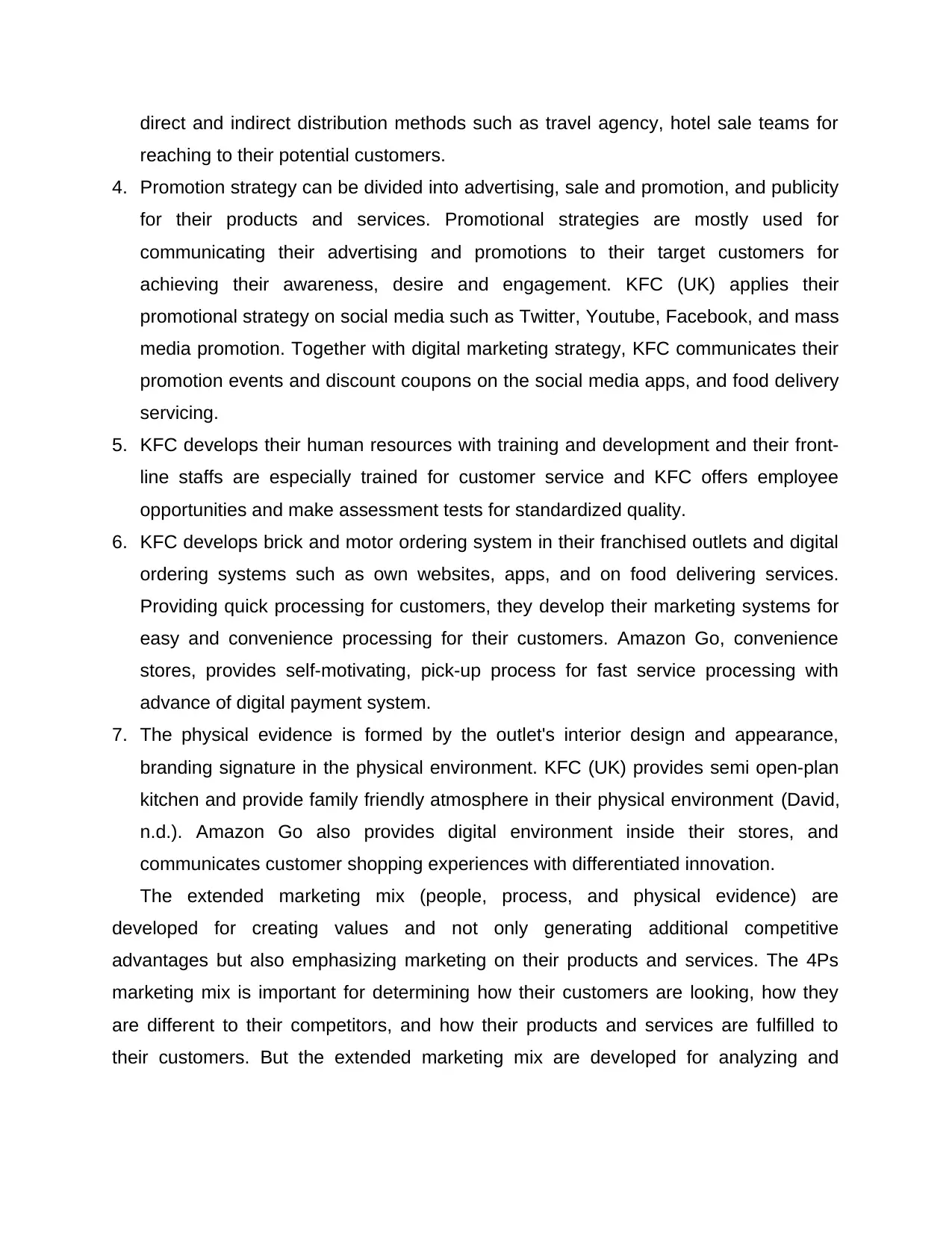
direct and indirect distribution methods such as travel agency, hotel sale teams for
reaching to their potential customers.
4. Promotion strategy can be divided into advertising, sale and promotion, and publicity
for their products and services. Promotional strategies are mostly used for
communicating their advertising and promotions to their target customers for
achieving their awareness, desire and engagement. KFC (UK) applies their
promotional strategy on social media such as Twitter, Youtube, Facebook, and mass
media promotion. Together with digital marketing strategy, KFC communicates their
promotion events and discount coupons on the social media apps, and food delivery
servicing.
5. KFC develops their human resources with training and development and their front-
line staffs are especially trained for customer service and KFC offers employee
opportunities and make assessment tests for standardized quality.
6. KFC develops brick and motor ordering system in their franchised outlets and digital
ordering systems such as own websites, apps, and on food delivering services.
Providing quick processing for customers, they develop their marketing systems for
easy and convenience processing for their customers. Amazon Go, convenience
stores, provides self-motivating, pick-up process for fast service processing with
advance of digital payment system.
7. The physical evidence is formed by the outlet's interior design and appearance,
branding signature in the physical environment. KFC (UK) provides semi open-plan
kitchen and provide family friendly atmosphere in their physical environment (David,
n.d.). Amazon Go also provides digital environment inside their stores, and
communicates customer shopping experiences with differentiated innovation.
The extended marketing mix (people, process, and physical evidence) are
developed for creating values and not only generating additional competitive
advantages but also emphasizing marketing on their products and services. The 4Ps
marketing mix is important for determining how their customers are looking, how they
are different to their competitors, and how their products and services are fulfilled to
their customers. But the extended marketing mix are developed for analyzing and
reaching to their potential customers.
4. Promotion strategy can be divided into advertising, sale and promotion, and publicity
for their products and services. Promotional strategies are mostly used for
communicating their advertising and promotions to their target customers for
achieving their awareness, desire and engagement. KFC (UK) applies their
promotional strategy on social media such as Twitter, Youtube, Facebook, and mass
media promotion. Together with digital marketing strategy, KFC communicates their
promotion events and discount coupons on the social media apps, and food delivery
servicing.
5. KFC develops their human resources with training and development and their front-
line staffs are especially trained for customer service and KFC offers employee
opportunities and make assessment tests for standardized quality.
6. KFC develops brick and motor ordering system in their franchised outlets and digital
ordering systems such as own websites, apps, and on food delivering services.
Providing quick processing for customers, they develop their marketing systems for
easy and convenience processing for their customers. Amazon Go, convenience
stores, provides self-motivating, pick-up process for fast service processing with
advance of digital payment system.
7. The physical evidence is formed by the outlet's interior design and appearance,
branding signature in the physical environment. KFC (UK) provides semi open-plan
kitchen and provide family friendly atmosphere in their physical environment (David,
n.d.). Amazon Go also provides digital environment inside their stores, and
communicates customer shopping experiences with differentiated innovation.
The extended marketing mix (people, process, and physical evidence) are
developed for creating values and not only generating additional competitive
advantages but also emphasizing marketing on their products and services. The 4Ps
marketing mix is important for determining how their customers are looking, how they
are different to their competitors, and how their products and services are fulfilled to
their customers. But the extended marketing mix are developed for analyzing and
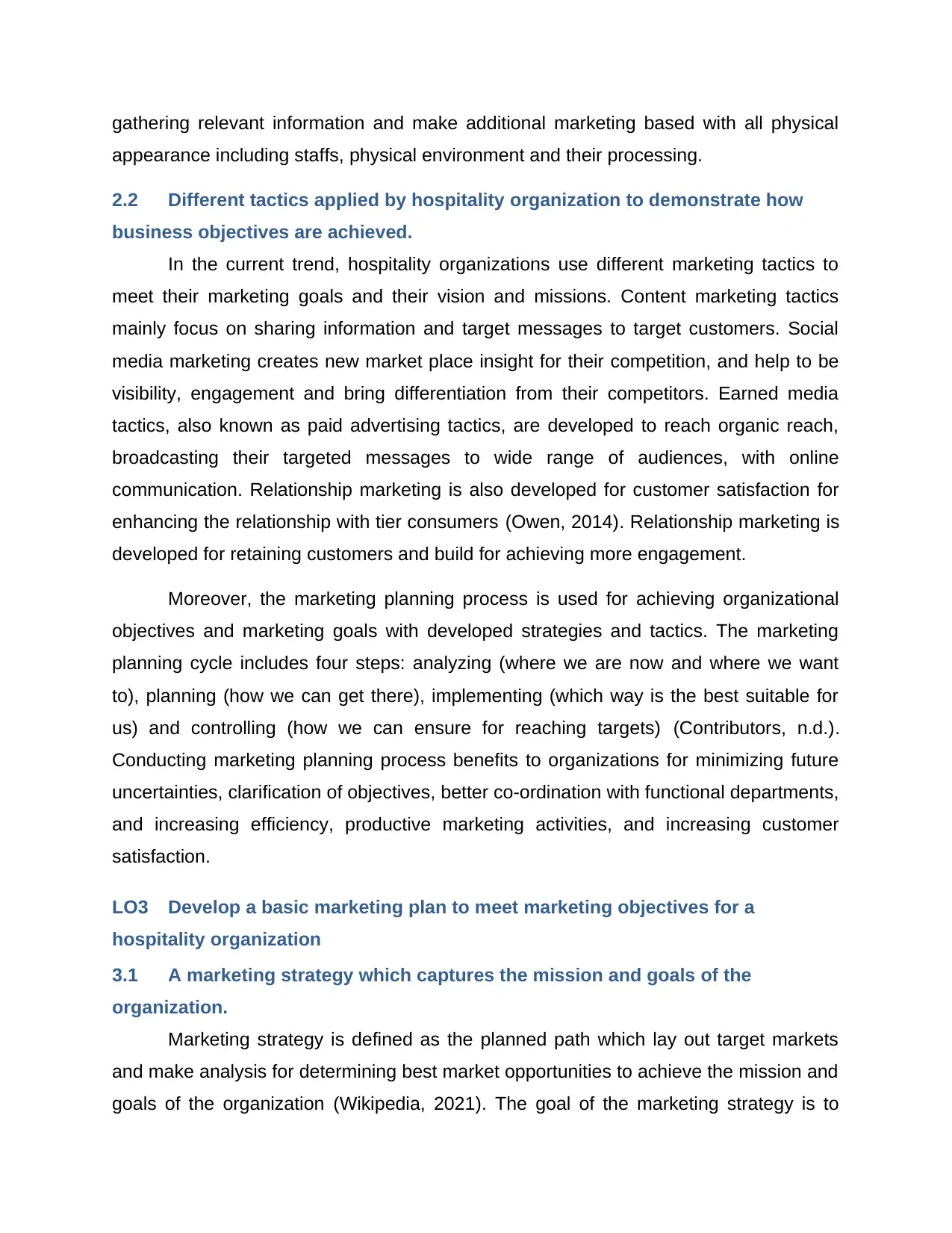
gathering relevant information and make additional marketing based with all physical
appearance including staffs, physical environment and their processing.
2.2 Different tactics applied by hospitality organization to demonstrate how
business objectives are achieved.
In the current trend, hospitality organizations use different marketing tactics to
meet their marketing goals and their vision and missions. Content marketing tactics
mainly focus on sharing information and target messages to target customers. Social
media marketing creates new market place insight for their competition, and help to be
visibility, engagement and bring differentiation from their competitors. Earned media
tactics, also known as paid advertising tactics, are developed to reach organic reach,
broadcasting their targeted messages to wide range of audiences, with online
communication. Relationship marketing is also developed for customer satisfaction for
enhancing the relationship with tier consumers (Owen, 2014). Relationship marketing is
developed for retaining customers and build for achieving more engagement.
Moreover, the marketing planning process is used for achieving organizational
objectives and marketing goals with developed strategies and tactics. The marketing
planning cycle includes four steps: analyzing (where we are now and where we want
to), planning (how we can get there), implementing (which way is the best suitable for
us) and controlling (how we can ensure for reaching targets) (Contributors, n.d.).
Conducting marketing planning process benefits to organizations for minimizing future
uncertainties, clarification of objectives, better co-ordination with functional departments,
and increasing efficiency, productive marketing activities, and increasing customer
satisfaction.
LO3 Develop a basic marketing plan to meet marketing objectives for a
hospitality organization
3.1 A marketing strategy which captures the mission and goals of the
organization.
Marketing strategy is defined as the planned path which lay out target markets
and make analysis for determining best market opportunities to achieve the mission and
goals of the organization (Wikipedia, 2021). The goal of the marketing strategy is to
appearance including staffs, physical environment and their processing.
2.2 Different tactics applied by hospitality organization to demonstrate how
business objectives are achieved.
In the current trend, hospitality organizations use different marketing tactics to
meet their marketing goals and their vision and missions. Content marketing tactics
mainly focus on sharing information and target messages to target customers. Social
media marketing creates new market place insight for their competition, and help to be
visibility, engagement and bring differentiation from their competitors. Earned media
tactics, also known as paid advertising tactics, are developed to reach organic reach,
broadcasting their targeted messages to wide range of audiences, with online
communication. Relationship marketing is also developed for customer satisfaction for
enhancing the relationship with tier consumers (Owen, 2014). Relationship marketing is
developed for retaining customers and build for achieving more engagement.
Moreover, the marketing planning process is used for achieving organizational
objectives and marketing goals with developed strategies and tactics. The marketing
planning cycle includes four steps: analyzing (where we are now and where we want
to), planning (how we can get there), implementing (which way is the best suitable for
us) and controlling (how we can ensure for reaching targets) (Contributors, n.d.).
Conducting marketing planning process benefits to organizations for minimizing future
uncertainties, clarification of objectives, better co-ordination with functional departments,
and increasing efficiency, productive marketing activities, and increasing customer
satisfaction.
LO3 Develop a basic marketing plan to meet marketing objectives for a
hospitality organization
3.1 A marketing strategy which captures the mission and goals of the
organization.
Marketing strategy is defined as the planned path which lay out target markets
and make analysis for determining best market opportunities to achieve the mission and
goals of the organization (Wikipedia, 2021). The goal of the marketing strategy is to
⊘ This is a preview!⊘
Do you want full access?
Subscribe today to unlock all pages.

Trusted by 1+ million students worldwide
1 out of 22
Related Documents
Your All-in-One AI-Powered Toolkit for Academic Success.
+13062052269
info@desklib.com
Available 24*7 on WhatsApp / Email
![[object Object]](/_next/static/media/star-bottom.7253800d.svg)
Unlock your academic potential
Copyright © 2020–2025 A2Z Services. All Rights Reserved. Developed and managed by ZUCOL.




